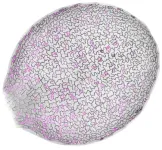(Press-News.org) Oregon Health & Science University researchers showed that consuming THC while pregnant could potentially affect development of the fetus and lead to life-long health impacts for offspring.
The preclinical study was published today in the journal Clinical Epigenetics.
Delta-9-tetrahydrocannabinol, or THC, is the main psychoactive ingredient in cannabis, a substance growing in popularity and availability in the United States. The prevalence of cannabis use in pregnancy is also rapidly increasing, especially during the first trimester — a time when the fetus is most vulnerable to environmental exposures — to mitigate common symptoms like morning sickness. However, the potential effects of prenatal cannabis use on fetal development remain inconclusive, in part due to a lack of safety data. This study aimed to identify the potential long-term health impacts of THC use during pregnancy.
In a non-human primate model, OHSU researchers found that exposing a pregnant subject to THC altered the placental and fetal epigenome —including the chemical modifications to DNA responsible for gene regulation and expression, that is telling genes what, where and when to do something. Researchers also found that that these changes to gene regulation and expression are consistent with those seen with many common neurobehavioral conditions, including autism spectrum disorder.
“Cannabis is one of the most commonly used drugs and is widely available across the country, so there is a common perception that its completely safe to use,” said the study’s lead author Lyndsey Shorey-Kendrick, Ph.D., a computational biologist in the Division of Neurosciences at OHSU’s Oregon National Primate Research Center, or ONPRC. “The reality is that cannabis still carries many health risks for certain populations, including those who are pregnant. If we’re able to better understand the impacts, we can more effectively communicate the risks to patients and support safer habits during the vulnerable prenatal period.”
In a model using nonhuman primates, researchers administered THC in a daily edible and compared its effects to a group receiving a placebo. Specifically, researchers evaluated the epigenetic changes in several key areas that indicate healthy prenatal development: the placenta — the disc of tissue that connects the umbilical cord and uterus — and fetal lung, brain and heart.
When looking at these areas, analyses showed that THC exposure altered the epigenome, meaning a process in which the information encoded in a gene is turned into a function or observable trait. Genes — the segments which make up DNA — are all specifically coded to contribute to different functions of the body and brain, so any impact on epigenetic processes due to drug exposure is concerning, especially during a critical developmental window such as pregnancy.
Researchers found that significant changes involved genes associated with common neurobehavioral disorders, including autism spectrum disorder and attention deficit hyperactivity disorder. These conditions are linked to adverse health outcomes in childhood and adolescence, including poorer memory and verbal reasoning skills, and increased hyperactivity, impulsivity and inattention.
The research team, which includes Eliot Spindel, M.D., Ph.D., Elinor Sullivan, Ph.D., Owen McCarty, Ph.D., and Jason Hedges, M.D., Ph.D., hopes findings from this study will add to the limited existing literature on THC use during pregnancy, and help guide patient counseling and public health polices focused on cannabis in the future.
“It’s not common practice for providers to discuss cannabis use with patients who are pregnant or trying to conceive,” said the study’s corresponding author, Jamie Lo, M.D., M.C.R., associate professor of obstetrics and gynecology (maternal-fetal medicine), OHSU School of Medicine, and Division of Reproductive and Developmental Sciences at the ONPRC. “I hope our work can help open up a broader dialogue about the risks of cannabis use in the preconception and prenatal period, so we can improve children’s health in the long run.”
Research reported in this publication was supported by the Reproductive Scientist Development Program, March of Dimes, March of Dimes Foundation, and Silver Family Innovation Award. The research was also supported by the Office of the Director, the Eunice Kennedy Shriver National Institute of Child Health and Human Development, and the National Institute on Drug Abuse, all of the National Institutes of Health, under award numbers P51 OD011092, K12 HD000849, R03 HD097116, and DP1 DA056493. The content is solely the responsibility of the authors and does not necessarily represent the official views of the National Institutes of Health.
All research involving animal subjects at OHSU must be reviewed and approved by the university’s Institutional Animal Care and Use Committee (IACUC). The IACUC’s priority is to ensure the health and safety of animal research subjects. The IACUC also reviews procedures to ensure the health and safety of the people who work with the animals. The IACUC conducts a rigorous review of all animal research proposals to ensure they demonstrate scientific value; justify the use of live animals and species selected; outline steps to minimize pain and distress; document appropriate training of all staff involved; and establish the proposed study does not unnecessarily duplicate previous research. No live animal work may be conducted at OHSU without IACUC approval.
END
THC use during pregnancy linked to changes in fetal development
OHSU researchers warn of potential impacts on brain development, long-term health related to prenatal cannabis exposure
2023-07-06
ELSE PRESS RELEASES FROM THIS DATE:
New insight into how plant cells divide
2023-07-06
Every time a stem cell divides, one daughter cell remains a stem cell while the other takes off on its own developmental journey. But both daughter cells require specific and different cellular materials to fulfill their destinies. Animal stem cells use the cytoskeleton – a transient network of structural tubules – to physically pull the correct materials from the parent cell into each daughter cell during the split. Plants also have stem cells that need to distribute different materials ...
Eliminating extra chromosomes in cancer cells prevent tumor growth
2023-07-06
New Haven, Conn. — Cancer cells with extra chromosomes depend on those chromosomes for tumor growth, a new Yale study reveals, and eliminating them prevents the cells from forming tumors. The findings, said the researchers, suggest that selectively targeting extra chromosomes may offer a new route for treating cancer.
The study was published July 6 in the journal Science.
Human cells typically have 23 pairs of chromosomes; extra chromosomes are an anomaly known as aneuploidy.
“If you look at normal skin or normal lung tissue, for example, 99.9% of the cells will have the right number of chromosomes,” said ...
Fantasy football in math class?
2023-07-06
While mathematics is a fundamental skill crucial to daily life, U.S. parents today see math education as boring, outdated, and disconnected from the real world. (1) At the national level, short and long-term achievement trends paint a disconcerting picture of the need for innovative math education strategies:
Math scores among eighth graders dropped in 2022, to the lowest score since 20031
Math scores declined for students regardless of racial and ethnic group, gender, parental education, or disability status1
The COVID-19 pandemic exacerbated declines in math achievement; the median school district lost about ...
Mobile phone data used for public health underrepresent vulnerable populations
2023-07-06
UNIVERSITY PARK, Pa. — Mobile phone data are increasingly used in public health management and disease outbreak response, as demonstrated during the COVID-19 pandemic when location data were used as a proxy for human movement and contacts and informed exposure notification apps. However, a new study led by researchers at Penn State revealed that phone data may not accurately reflect under-resourced or particularly vulnerable populations, who are often underrepresented in other data as well.
If this bias is not acknowledged or complemented with additional ...
Researchers discover potential molecular indicators for Parkinson’s symptoms
2023-07-06
Hand tremors and slowed movements are two of the most widely recognized hallmarks of Parkinson’s disease, and for many sufferers the first indication that something is amiss. But by the time these symptoms manifest, those patients have already lost 50–80 percent of their dopamine neurons—a mass die-off that causes the neurodegenerative disease. Malfunctions in dopamine-dependent areas of the brain are responsible for many of the symptoms, which differ from person to person in an unpredictable way.
A diagnosis at an early age, typically before age 50, can stave off the most severe symptoms for years; when the disease is identified later, its trajectory is often swift ...
Study supports “catch up” HPV test in older women
2023-07-06
For women over the age of 65 who have never had a high-risk human papillomavirus (HPV) test, a “catch up” HPV screening intervention may improve cervical cancer prevention by detecting more cervical pre-cancer lesions as compared to women not offered screening. That is the conclusion of a new study publishing July 6th in the open access journal PLOS Medicine by Mette Tranberg, University Research Clinic for Cancer Screening, Randers Regional Hospital, Denmark, and colleagues.
High-risk human papillomavirus (HPV) test is replacing cytology as the primary cervical cancer screening test in most countries, but many women over 65 years have never had an HPV ...
The solstice switch: Warming’s effects on autumn leaf senescence depend on timing
2023-07-06
How temperate and boreal trees’ leaves respond to climate change remains uncertain. Now, a new study of northern forests reports that while early-season climate warming – that occurring before the summer solstice – tends to be associated with earlier autumn leaf senescence, late-season warming (after the summer solstice) has the opposite impact, delaying onset of leaf senescence in fall. “Improved models of plant development and growth under climate change will need to incorporate the reversal of warming effects after the summer solstice,” write Constantin Zohner and colleagues, authors of the study. Climate change ...
Two studies report: Perovskite-silicon tandem cells that break the 30% efficiency threshold
2023-07-06
In two separate studies, researchers present novel methods that enable the fabrication of high-performance perovskite-silicon tandem solar cells with power conversion efficiencies exceeding 30%. Silicon solar cells – the most commonly deployed photovoltaic (PV) technology – are rapidly approaching their theoretical power conversion efficiency (PCE) limit of 29%. One way to increase the efficiency of a solar cell is to optimize the spectrum of sunlight for conversion into energy. This can be done by stacking two or more interconnected photoactive materials into a singular device, improving ...
Precipitation tolerance helped explain which vertebrate species spread between newly joined continents
2023-07-06
A new study helps explain why rates of species exchange are at least twice as high from west to east than in the opposite direction across Wallace’s Line. The study included an analysis of more than 20,000 species belonging to all 227 families of terrestrial vertebrates present in the Indo-Australian archipelago. As tectonic plates merge, once disparate continents can connect and create new opportunities for biotic exchange. Species movement across newly connected continents millions of years ago continues to shape assemblages of flora and fauna today. One of the most well-known ...
Ready for its close-up: The electron’s permanent electric dipole moment
2023-07-06
A new study with direct implications for one of the most important unresolved questions in physics – the imbalance of matter and antimatter in our universe – reports “the most precise measurement yet” of the size of the electron’s permanent electric dipole moment. The imbalance between matter and antimatter in the Universe can be explained via the breaking of charge parity symmetry. The standard model (SM) of particle physics predicts a slight breaking of this symmetry, but it is insufficient to explain the imbalance actually observed. Many extensions to the standard ...
LAST 30 PRESS RELEASES:
New evidence challenges understanding of Parkinson’s disease
A new study reveals how embryos and the uterus “talk” during implantation
Cedars-Sinai reports heart attacks, general illness spiked after LA fires
PolyU develops ultra-stable, mucus-inspired hydrogel to boost gastrointestinal wound healing
Flour choice shapes sourdough microbial communities
Can a retinal implant reverse macular degeneration?
Feeding fungi plant remnants produces tasty protein to fortify vegan, vegetarian diets
New tech reduces false positives from breast ultrasounds
Drone-mounted lab monitors fertilizer runoff in real time
Short, light-intensity exercise boosts executive function and elevates mood in children
Jeonbuk National University researchers reveal new interface engineering strategy for efficient and stable back-contact solar cells
Tyrosinase drives hydroquinone-induced exogenous ochronosis: not HGD inhibition
UMass Amherst chemists develop unique tool for studying RNA
Disappointment alters brain chemistry and behavior
A built-in odometer: new study reveals how the brain measures distance
Stress-related brain signals drive risk of cardiovascular disease in people with depression and anxiety
New details on role of fat transport molecules in Alzheimer’s onset
Study illuminates how an antiviral defense mechanism may lead to Alzheimer’s disease
Spot the males: New gene-editing method could transform mosquito control
AI learns to build simple equations for complex systems
NAU team releases 13 years of detailed U.S. CO2 emissions data
Unveiling how sodium-ion batteries can charge faster than lithium-ion ones
How do childcare tax credits affect children’s long-term health?
Can an electronic nose detect indoor mold?
Do natural disasters have long-term impacts on mortality in older adults?
Modification improves sodium‐ion batteries as an alternative to lithium-ion batteries
Parasports provide a range of benefits for people with cerebral palsy
How does grandparental care affect children’s health?
Why are there so many Nordic mediators?
Young shark species more vulnerable to extinction
[Press-News.org] THC use during pregnancy linked to changes in fetal developmentOHSU researchers warn of potential impacts on brain development, long-term health related to prenatal cannabis exposure



